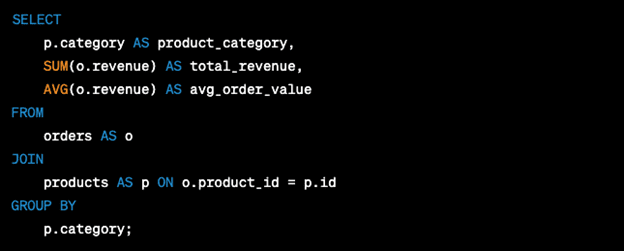Imagine you’re working at a retail company, and you’ve been asked to analyze the sales data to find the total revenue and average order value for each product category. You have two tables – ‘orders’ and ‘products.’ The ‘orders’ table contains information about each order, including the order ID, product ID, and revenue. The ‘products’ table contains information about each product, including the product ID, name, and category. Using SQL aliases can make your query more readable and easier to write.
Here are step-by-step instructions in the context of this scenario:
- Begin by writing a SELECT statement to retrieve the required columns. In this case, we want to retrieve the product category, total revenue, and average order value.
- Use aliases to give more meaningful names to the columns in the output. For example, you can use the alias ‘total_revenue’ for the sum of the revenue column and ‘avg_order_value’ for the average order value.
- Use aliases to simplify references to tables when you join them. For example, you can use the alias ‘o’ for the ‘orders’ table and ‘p’ for the ‘products’ table.
- Use GROUP BY to group the results by product category, then use the aggregate functions SUM() and AVG() to calculate each group’s total revenue and average order value.
Here’s an example query:
Breaking down the query:
- SELECT p.category AS product_category: This selects the ‘category’ column from the ‘products’ table (aliased as ‘p’) and renames it ‘product_category’ in the output.
- SUM(o.revenue) AS total_revenue: This calculates the sum of the ‘revenue’ column from the ‘orders’ table (aliased as ‘o’) and renames it ‘total_revenue’ in the output.
- AVG(o.revenue) AS avg_order_value: This calculates the average of the ‘revenue’ column from the ‘orders’ table (aliased as ‘o’) and renames it ‘avg_order_value’ in the output.
- FROM orders AS o: This specifies the ‘orders’ table as the main table in the query and assigns it the alias ‘o’.
- JOIN products AS p ON o.product_id = p.id: This joins the ‘products’ table (aliased as ‘p’) to the ‘orders’ table (aliased as ‘o’) using the ‘product_id’ column from the ‘orders’ table and the ‘id’ column from the ‘products’ table.
- GROUP BY p.category: This groups the results by the ‘category’ column from the ‘products’ table (aliased as ‘p’).
Using aliases makes the query more readable and easier to write, helping you efficiently analyze the sales data.
